Genealogical Tidbits
Bits and Pieces of
Random Knowledge
Recently, I checked back to the last column I wrote that preceded my regular role as a monthly contributor of articles inspired by my love of genealogy. This was published in May of 2015 before I took up the challenge to write the regular column that started in September of the same year. In this article, I mentioned the stories from my two grandmothers, Grandmother Nora Viola Alexander Carroll Fisher King (paternal line who kept no written tree or Bible records but who had, obviously, been regaled with her heritage and knew it by heart) and my Grandmother Carrie Edyth Bullard Joslin (who had the Bible records, a hand-written family tree, three or more photocopied books from the Hopper, Joslin and Bullard lines, reams of letters to family members, information she shared with noted Joslin biographer Edith S. Wessler [Wessler, Edith S. (Edith Marguerite Stanley). The Jocelyn--Joslin--Joslyn--Josselyn family. (St. Louis, Missouri: E.S. Wessler, c1961, 1962)] and oral histories by the ton!
I looked for that Joslin book for decades before finally locating a publisher who specialized in finding out-of-print family histories and offering photocopied versions. I bought mine for $50.00 plus tax about 15-20 years ago and later bought the two volume update offered by Edith Wessler's daughter, Carol Wessler Treadway who, in concert with our family's professional genealogist Roger D. Joslyn, and fellow family historian, Roland Joslin of Grandview, Texas, sought to correct errors in her mother's original work. I am so glad I made the purchase of that first Wessler book for now it is to be found listed at about $600.00 for a print! The books published by her daughter are nicely bound in deep, rich green with gilt lettering and make very nice additions to my Family Tree Library.
These
three books offer historical knowledge of the Joslin family, which is reputed
by many to have originated through the relationship of Charlemagne with one of
his eighteen wives and/or concubines. If that is, in fact, true - and I am one
who believes it to be true - that takes this branch of our family line back
into about 430 BC with Charlemagne's earliest known paternal Frankish king
ancestor. In those ancient, misty times no surnames existed. There were so few
peoples that only given names existed. Later, as the population increased and
given names were repeated endlessly by tradition of honoring prior ancestors by
giving new children the same names, it became necessary to distinguish one
person from another by three primary methods:
1. trade or occupation or honor/title (thus the Bullard name was
originally a "buller" or a keeper and breeder of bulls, Jagger
from the street merchant in medieval England who carried his goods in a large
bag tied to a stick propped over his shoulder - or his 'jag"),
2. by relationship so that Anderson was the son of
Ander, Jonsonsdottir was the daughter of Jonson, and so forth,
ultimately leading to the fixing of surnames to distinguish the line; or
3. by location. Cohenour, for instance, derived
from the place name Goch or Hills, Gochen denoted the people
living on the hills, and Gochenour referred to those same hill people
who had migrated elsewhere), Today no less than sixty-four spellings of the
Cohenour surname are accepted and relate to the same family line that
originated in the Alsace-Lorraine region of France.
One of the reasons I feel so strongly about
researching our family lines is my belief that we are truly crafted,
individualized, and influenced by the characters who preceded us in that long
line of DNA. Perhaps we even “inherit” our likes and dislikes, habits, artistry
and skills from not only the people who lent their piece of DNA but by the very
sights, sounds, and events that affected their lives. For instance, my husband, a Cohenour, has
always shown a distinct love for any piece of land that shows green grass
bordered by a white fence. Come to find
out that was the primary property boundary for folks in the hills of Alsace-Lorraine!
I have a love of water mills. Have been fascinated by their beauty since my earliest memory. One of the first good oil paintings I ever did was of the Mabry Mill, the painting on the right in this picture. (Photo of Mabry Mill below.)
In researching my family history, I find that my immigrant Creek ancestor (whose name in Germany was Guilliam Grieg anglicized to Killian Kreek) was made famous for his architectural and construction skills. What remains of his water-powered Mill is now listed on the Register of Historic Places in Kentucky – Killian Creek’s Mill. In the photos shown here, one black and white photo shows the mill as the scene of a baptism in 1910, (see pic at bottom of page) one provides a side view with the wooden superstructure still mostly intact, and the color photo depicts the remaining foundation of stone built by Killian which, in an attempt to help preserve it, has been given modern roof.
Side view.
Remains of foundation Killian built.
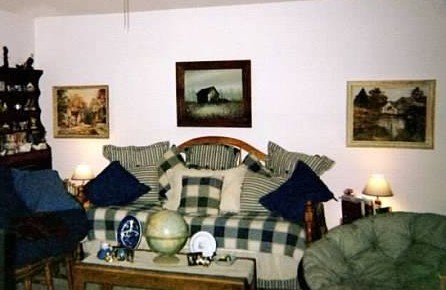
|
I have a love of water mills. Have been fascinated by their beauty since my earliest memory. One of the first good oil paintings I ever did was of the Mabry Mill, the painting on the right in this picture. (Photo of Mabry Mill below.)
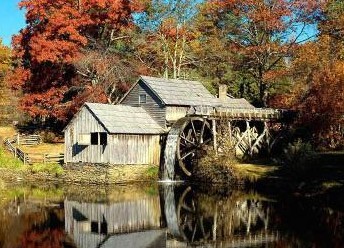
|
In researching my family history, I find that my immigrant Creek ancestor (whose name in Germany was Guilliam Grieg anglicized to Killian Kreek) was made famous for his architectural and construction skills. What remains of his water-powered Mill is now listed on the Register of Historic Places in Kentucky – Killian Creek’s Mill. In the photos shown here, one black and white photo shows the mill as the scene of a baptism in 1910, (see pic at bottom of page) one provides a side view with the wooden superstructure still mostly intact, and the color photo depicts the remaining foundation of stone built by Killian which, in an attempt to help preserve it, has been given modern roof.
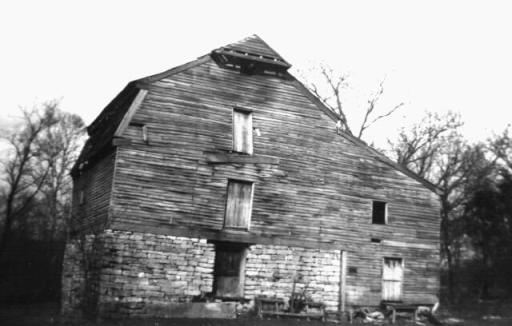
|
Side view.
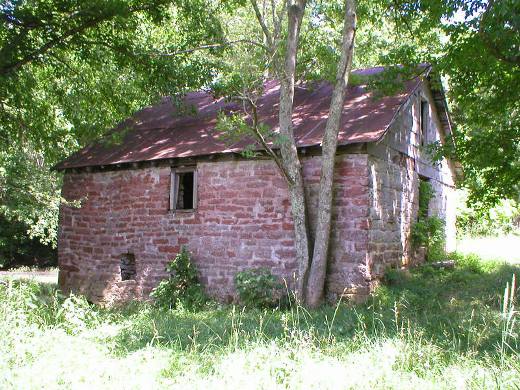
|
Remains of foundation Killian built.
My endless research into our family’s list
of characters and the events that affected their lives has led me to some
fascinating discoveries and has involved some real mysteries. In order to
unravel some of those mysteries, I’ve had to incorporate into my research some
insight into the change in writing styles through the centuries in order to
transcribe handwritten documents, naming conventions, how we relate to one
another through the siblings of our ancestors, plagues and natural events that
may have contributed to the deaths of those ancestors, and the wars that
brought about great heartaches, tremendous losses and incredible acts of
bravery. Since most family tree software
applications and even the sophisticated tools available through Ancestry.com do
not provide all the cross-checks essential to discovering possible clues to
such things as the maiden names of our oft-forgotten grandmothers through the
centuries, or the parentage of blood-line relatives, I have resorted to a
complicated set of files within my computer that include folders for things
such as 17th Century Historical Information, Land Ownership Facts,
Plagues, Military Men of the Carroll-Joslin Line, Correspondence from
Researchers, and the like. In those
folders, I have prepared aids to my research that include the use of
spreadsheet applications.
One of those ongoing spreadsheets is one
still in the process of fine-tuning that was created as a tool to unravel my
biggest mystery: the link between my known and proven 3rd
Great-Grandfather William “P. R.” Joslyn and his parents. A DNA test graciously provided by my maternal
Joslin uncle has led to the discovery of some very close hits. One must rely
upon the documentation of family lineage of such a match, of course, in order
to give credence to the ancient lines to which they lay claim. My Joslin DNA matches include those whose
Joslin lines lead clearly and distinctly to our Immigrant Ancestor, Thomas
Joslin (the ship’s manifest of the Increase in 1634 listed Thomas’ surname as
“Jostlin” and provided the names of his wife, Rachel, their children and
maid-servant.) So, I now have excellent proof that our line leads back to
Thomas “The Immigrant” Joslin. However,
there is a break in the line – a brick wall when it comes to the actual
parentage of our William “P.R.” Joslyn and just how he is related to Col.
William “of Deerfield” Joslin (1701-1771).
Family history states great grandfather
William Henry Joslin was told by his father, Riley, that Riley was “the son of
William, son of William, son of William.” Since most of the William Joslins who
were alive and appearing on the US Census in the 1800’s are related in some way
to our own line, my spreadsheet attempts to capture the various facts that have
been revealed for each William Joslin through the years. The columns list such
things as Date of Birth, Date of Death, US Census Date (and relevant entries
captured by the comment capability of my Excel application), City, County,
State for each such fact. It is a rather
complicated spreadsheet and has the potential of growing beyond the bounds of
both my creativity and the structure of the application itself. When preparing
this spreadsheet, I became fascinated by the coincidence of appearance of
various branches of my family in the same locations on the same dates via
Census and other records. A second
spreadsheet has sprung forth attempting to cross-reference those coincident
occurrences. (I REALLY wish Ancestry would come up with a way to utilize their
tremendous search engines to sort all profiles by date and location…Wow!
Wouldn’t that be a great tool? I will provide that as my latest suggestion for
improvement since some of my suggestions have now been incorporated. Who
knows? Our very first tree application
offered that capability, where you could pick the Facts you wanted to sort and
play with your associations. Unfortunately, that software had a capacity that
was long since exceeded by my research.)
Another fascinating list is the one started
to memorialize the contributions of our ancestors to the building and
preservation of our great country. This
listing has been divided by major war, prominently including the Revolutionary
War. The list is a Word document. When
research uncovers a new military connection, this list is opened in a second
window and pertinent facts relating to the person and his/her military service
is popped in under the relevant War. By this listing we are now documented to
descend from no less than eleven Revolutionary War Patriots, all by direct
bloodlines. The list begins with an
entry for The Crusades and our 24th great grandfather, Hugues de
Payens (DuPuy) who, along with his cousins and other kinsmen, were the original
Knights Templar who protected Christians on their trips to the Holy Land.
The cousin relationship is one of the most
complex of all. Most of our tree will always be occupied by cousins: first
cousins, first cousins once/twice/thrice removed, eighth cousins…the list is
endless. The relationship is so complex that one must usually resort to a chart
prepared to cross index it. Perhaps the easiest way to remember the basic
“cousinships” is your first cousin is the child of one of your parent’s siblings;
therefore you and your first cousin share GRANDPARENTS. Your second cousin is
your PARENT’s first cousin. But the first cousin, once removed is the cousin of
your grandparent or the child of your grandparent’s sibling. As I said, there are charts to which one can
refer, but a good family tree software will automatically provide the
relationship for you.
Naming conventions offer both the biggest
stumbling block and aggravating puzzlement to a researcher and one of the
greatest methods for tracking associated families. Old English families gave
honor to first the husband’s father for the first-born son, then the wife’s
father for the second-born son. Third and fourth sons might be named in honor
of the father’s favorite or eldest brother and so forth. This led to the
replication of the same names for generation after generation with each son of
the grandparent naming their first-born son similarly. Thus, the proliferation
of William Joslins in our tree. Second
given names did not come into vogue for some time. These second given names are sometimes
valuable clues to the maternal line’s surnames. In this fashion, a first-born
son might be named John Kellogg Jones where John was his father’s father’s
name, Kellogg might have been his mother’s maternal surname and Jones would, of
course, be the surname for his paternal line.
These naming conventions differ by nationality, by race and by belief.
Chinese families actually list their surname first so that Li Xiang would be
the son, perhaps, of Li Pei. In pursuing Native American ancestors the naming
conventions were truly confusing for one person might have several names by
which they were called, depending upon the situation. Many tribes were
maternalistic so that the mother’s line would be honored as the surname. Also,
a feat of bravery or humor might grant an individual a new nomination.
And, to harken back to my Joslin DNA issue,
the closest “hit” or match for my uncle’s DNA was that of a man who had been
adopted at an early age. His DNA had
been offered by his daughter who wished to help her aging father in his
lifetime’s quest for confirming his real identity. Rather than identify this
man or his daughter, I shall refer only to the methods we’ve used in trying to
close the gap to identify my uncle’s and her father’s MRCA or Most Recent
Common Ancestor. My own efforts led to me starting a new family tree on
Ancestry devoted to this line of inquiry. Originally, the daughter and I
started email conversations. Her father had never been told the truth of his original
family. He was told his parents both died in the 1918 Spanish Flu epidemic and
that they were English. Not true. The mother and one twin daughter succumbed.
The father, son and remaining twin daughter survived. When the daughter found
that her grandfather was actually still living when her father was given up for
adoption, the natural question was “Why would he abandon his children?” Through
endless research, I was able to show that rather than being an unfeeling ogre
who abandoned his children, this man was a hero. He was a Navy medic who had
extensive medical training from a career in the military. When his wife and
infant daughter were hospitalized, he worked tirelessly, side-by-side with the
doctors who were overwhelmed with the numbers of patients. He even contracted
and was successfully treated for the flu himself. He had a remaining obligation
to the Navy that he fulfilled. His sister lost her father-in-law, and
brother-in-law and the entire family was thrown into a state of disruption by
the emotional and financial stress brought about by this plague. Shortly after
the two of us began researching, I was contacted by a third researcher – the
granddaughter of the surviving twin daughter whose grandmother was also given
up for
adoption.
Westcott Campbell Joslin, Sr
Our research has culminated in tracing the principal, the father of my uncle’s DNA match. His name was Westcott Campbell Joslin, Sr. He was the child of Walter F. Joslin, a barber, in Camden, New Jersey, and his wife, Mary Campbell. Walter’s parents were Edward S. Joslyn, a silversmith, and Nancy A. Rasor of Paducah, Kentucky. We have information that our Joslin line had connections to John Joslin, the Patriot, through whom most Joslin families claim their DAR and SAR memberships. John relocated from New Jersey to Kentucky. Records from Kane County, Illinois, histories indicate that my 3rd great grandfather William “P.R.” Joslyn traveled from New Jersey to Kentucky before migrating to Pennsylvania, Ohio, Iowa, Indiana, and Illinois before his death in 1846. John Joslin was the first-born son of Col. William “of Deerfield” Joslin (1701-1771) by his first wife, Mary MNU. One of these days, I hope soon, that brick wall will crumble. I will find the father of Edward S. Joslyn b. 1826 and how he was related to my 3rd great grandfather, William “P.R.” Joslyn b. abt 1760 to 1796 (different records show that wide deviation in birthdates).
adoption.
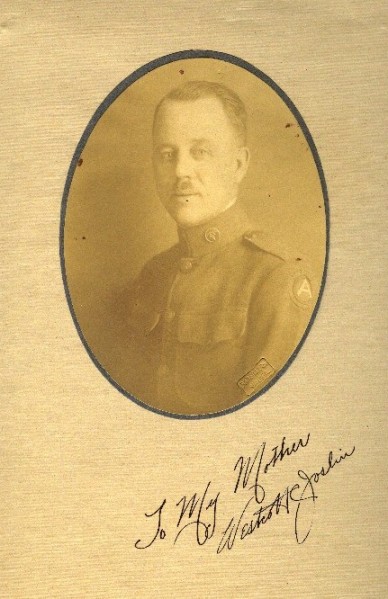
|
Westcott Campbell Joslin, Sr
Our research has culminated in tracing the principal, the father of my uncle’s DNA match. His name was Westcott Campbell Joslin, Sr. He was the child of Walter F. Joslin, a barber, in Camden, New Jersey, and his wife, Mary Campbell. Walter’s parents were Edward S. Joslyn, a silversmith, and Nancy A. Rasor of Paducah, Kentucky. We have information that our Joslin line had connections to John Joslin, the Patriot, through whom most Joslin families claim their DAR and SAR memberships. John relocated from New Jersey to Kentucky. Records from Kane County, Illinois, histories indicate that my 3rd great grandfather William “P.R.” Joslyn traveled from New Jersey to Kentucky before migrating to Pennsylvania, Ohio, Iowa, Indiana, and Illinois before his death in 1846. John Joslin was the first-born son of Col. William “of Deerfield” Joslin (1701-1771) by his first wife, Mary MNU. One of these days, I hope soon, that brick wall will crumble. I will find the father of Edward S. Joslyn b. 1826 and how he was related to my 3rd great grandfather, William “P.R.” Joslyn b. abt 1760 to 1796 (different records show that wide deviation in birthdates).
Research will continue. My armchair search
will carry me to places and times of great mystery, some sadness (for I still
tear up at times when I discover the hardships that brought loss of children,
babies, husbands, through war, accident, plague or meanness) and, oft-times,
great jubilation at how steadfast and true my ancestral line has been.
Researched and Compiled by author.
Click on author's byline for bio and list of other works published by Pencil Stubs Online.
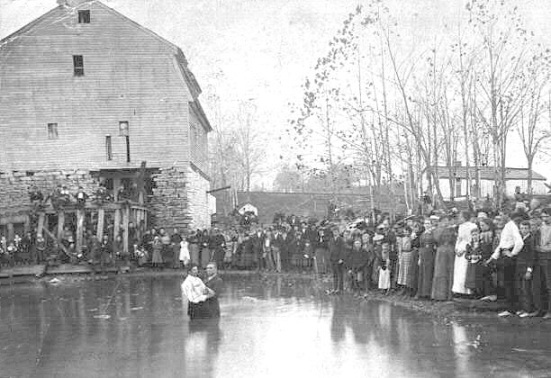 |
| 1910 Baptism at Kreig Mill |






No comments:
Post a Comment